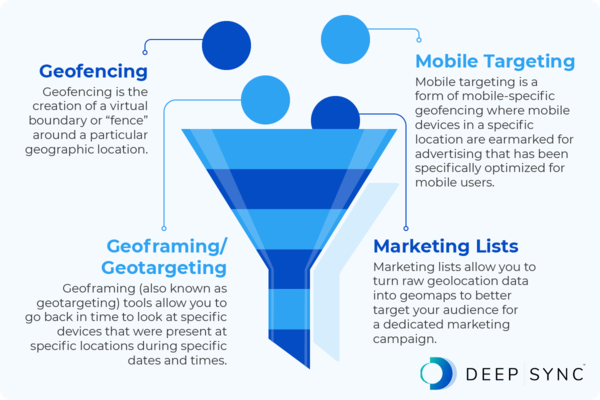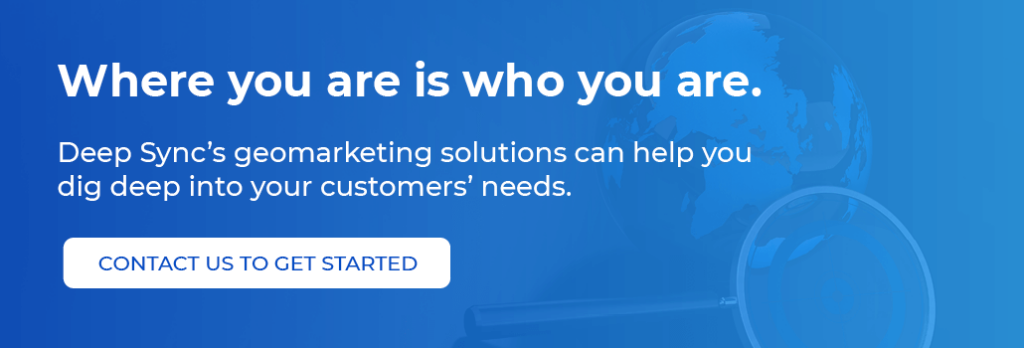As remote work environments and digital engagement enable the average consumer to travel wherever and whenever they want, geomarketing is a trend that’s become increasingly important for businesses of all sizes. In fact, geomarketing is a nearly $11 billion market, and that number is expected to triple in the next five years as this location-based technology evolves.
So, how do you explain the boom in geomarketing? Clearly, businesses see the value in this highly-targeted marketing strategy, which empowers them to reach audiences (at the right time and in the right places) who are most receptive to their messaging.
If you’re interested in leveraging this powerful advertising technique, but unsure about where to begin, we’re here to provide you with all the information you need to launch your own intelligent geomarketing strategy. Throughout this guide, we’ll address:
- What Is Geomarketing?
- Geomarketing Variations
- Benefits of Geomarketing
- Best Practices for Incorporating Geomarketing into Your Strategy
Eager to learn more about geomarketing and how it can enhance your current marketing strategies? Let’s kick things off with a brief overview.

What Is Geomarketing?
Geomarketing is the practice of using location data to identify and serve marketing messages to a highly-targeted audience. Essentially, geomarketing allows you to better serve your audience by giving you an inside look into where they are, where they have been, and what kinds of products or services will appeal to their needs.

For example, geomarketing gives you the insight to not advertise space heaters to someone currently sunbathing in the Florida Keys, but instead to someone braving a sub-zero Minneapolis winter. Additionally, it can clue you into the fact that a consumer who’s visited several clothing retailers may be looking to upgrade their wardrobe.
The core principle behind geomarketing is that “where you are is who you are.” In other words, where your customers live and spend their time can tell you a lot about them—including their purchasing intent.
In terms of technology, geomarketing involves using specialized geomapping tools (such as the comprehensive mapping tools offered by Compact) to identify target audiences that meet a series of criteria. This enables you to catch customers who are in an opportune location or are part of an opportune audience more likely to respond well to your advertising campaign.
Geomarketing Variations

As we mentioned, geomarketing is the larger practice of using geolocation data to create targeted advertising. But underneath the umbrella term of geomarketing are several different types of location-based marketing strategies and tools for you to consider.
As you think about how geomarketing can strengthen your specific business’s approach to customer outreach, take a look at some (or all) of the major forms of geomarketing you might take advantage of:
- Geofencing. Geofencing is the creation of a virtual boundary or “fence” around a particular geographic location, such as a home or business. Devices located inside that boundary, such as consumers’ cell phones, laptops, and tablets, will be tagged for advertising, with the idea typically being that all devices are sent advertisements while in the area and even after they leave for a period of time. One example of this is AccuData’s Addressable GeoFence service.
- Geoframing. Also known as geotargeting, geoframing is used for specific audiences that have visited an event or venue. Geoframing tools allow you to go back in time to identify specific devices that were present at specific locations during specific dates and times—and then market something to the users of these devices after the fact. For instance, this tool is ideal for reaching sports fans that attended a big game or business buyers that recently attended a specific conference.
- Mobile targeting. Did you know that 61% of smartphone users say they’re more likely to buy from mobile websites and apps that customize content based on their location? Mobile targeting is a form of mobile-specific geofencing in which mobile devices in a specific location are earmarked for advertising that has been specifically optimized for mobile users. Popular mobile targeting services include Mobile GeoFence and GeoFollow.
- Marketing lists. These are specialized lists of consumers, houses, apartments, and other target groups that have been compiled through geomapping tools. Compact offers access to this type of geomarketing in the form of our powerful mailing list services and comprehensive mapping technology. This mapping technology allows you to turn raw geolocation data into geomaps to better target your audience for a dedicated marketing campaign. These lists can be especially useful to improve the performance of direct mail marketing.
These tools form the backbone of geomarketing, and they each serve a unique purpose to maximize the success of your advertising campaigns.
However, if you’re still weighing the pros and cons of whether or not to infuse geomarketing into your current advertising practices, there are two main things you’ll want to consider: how specific geomarketing providers can help your business, and the core benefits of geomarketing.
Benefits of Geomarketing
So what are those core benefits? With geolocation data informing your marketing campaigns, you will be able to:
- Reach your local audience more effectively. Geomarketing can boost your business’s brand awareness in the local community by showing residents that your offerings are relevant and valuable.
- Reach a highly targeted audience. You won’t waste marketing dollars on creating and sending ads to a wider audience of individuals who may not be interested in your product.
- Connect with target audiences after they’ve left a location. You can keep the conversation going by continuing to serve relevant ad content to targeted audiences, even after they’re no longer at a certain location.
- Create more relevant and personalized content. The more you learn about your audience through the geomarketing process, the better you’ll be able to create marketing materials that appeal to their interests.
There’s a reason that geomarketing is counted among some of the fastest-growing and most effective marketing strategies in the world. As your consumers continue to spend more time on their devices and geographic data becomes more readily available, geomarketing allows you to capture and read this information in real-time to catch precisely the right audiences for your messaging at precisely the right moment.
Best Practices for Incorporating Geomarketing into Your Strategy
At this point, you might be ready to dive into geomarketing. If so, review these steps to carefully integrate geomarketing into your current marketing strategies:
Set goals.
As we saw, there are several different types of geomarketing tools, each with its own uses, benefits, and modes of operation. So, before you jump in and start selecting your geomarketing tools, you need to ask yourself a few important questions about your main marketing objectives.
For example, are you looking to:
- Break into a new market?
- Increase local brand recognition?
- Boost traffic to your eCommerce store?
- Increase foot traffic to your physical location?
By taking a moment to consider what you want out of your geomarketing strategy, you’ll be far better equipped to choose the best tools and approach to suit your needs.
Define your target audience.
Once you’ve firmly established the main objectives for your geomarketing campaign, the question becomes: Who is the most important target audience for your particular goods, services, or campaign?
After all, geomarketing is a technique that can help you to identify where, when, and who is among your chosen audience—but only after you’ve drawn out the boundaries of the kinds of individuals you want to target. For example, for a geoframing tool to be effective, you need to have decided on a specific date and location to look back at before you can send advertisements to prospective consumers.
To effectively identify your target audience or audiences, you should:
- Review your audience data using internal and external sources. Your first and best resource for finding potential audiences is looking at your current consumer records. Additionally, maintaining high data hygiene standards and supplementing your records with third-party data from a data append service provider can help you to fill in informational gaps, discover new lookalike audience segments, and further narrow down your target audience.
- Create user personas. Personas are archetypes of the consumers who typically buy your products or engage with your marketing materials. By using consumer data to create personas, you can better understand the specific behaviors, goals, and motivators of your real-life audience, allowing you to more effectively build out your messaging, guess how they might behave, and predict where they might spend their time.
Once you have your goals and audiences defined, you can then take the next step to determine the specific times and locations to reach them. You’ll want to engage them at the locations they visit often, such as their homes, workplaces, favorite stores, and event venues they attend.
Optimize your marketing messages.
Once you’ve narrowed down your target audience, location, and timing, you’ll need to develop a compelling message that captures customers’ attention and encourages them to engage with you further. When you’re designing your messaging, consider:
- Personalizing your outreach with audience members’ preferred names and engagement histories, as well as dynamic text and images.
- Ensuring your direct mail and digital ads are well-designed and effectively and consistently branded to your organization.
- Offering a variety of possible touchpoints with prospective customers through multiple channels and platforms.
Wherever your message appears, it should focus around a call to action that brings your audience to the next step in their sales journey.
Optimize your digital content for SEO and user-friendliness.
Finally, you’ll want to make sure your digital marketing presence is well-designed and optimized for local SEO.
Once you’ve successfully brought your audience members to your website, you want to make it as easy as possible to convert those visitors into purchasers. To give your potential customers a positive experience and set yourself up for success, follow these best practices:
- Use locally-relevant keywords. Conduct keyword research to identify search terms that are relevant to your product and key demographics. Then, use these keywords in specific page headings and titles.
- Publish quality and timely content. Users and search engine crawlers alike look at a page’s usefulness and accuracy to determine its value. Make sure your content is proofread and up-to-date.
- Incorporate simple navigation. Direct your direct mail and/or digital ad audience to a simple landing page or use clearly labeled menus and call-to-action buttons to direct visitors to important product and purchase pages. As you do this, streamline the checkout process. For example, visitors don’t want to have to first go through the rigamarole of creating an account in order to make a simple purchase.
- Prioritize site accessibility. Ensure your visual elements are optimized for accessibility by providing transcripts for video content, including descriptive alternative text for images, and offering tools to change text contrast and size.
- Optimize for all devices. Especially if you’re marketing directly to mobile devices, many of your visitors will access your website via their phones. Thus, it should have a responsive design that adjusts to fit different screen sizes.
Ultimately, even when your geomarketing strategy sends the perfect consumers your way, the quality of your website will determine whether they take the next steps to make a purchase.
In Summary
As the world of marketing and marketing technology rapidly evolves, this is both an exciting and daunting time to be a business leader.
After all, with the wide availability of user devices and geolocation tracking, there’s an incredible amount of consumer data that’s just waiting to be read, organized, and used by your organization.
For further information on the different ways you can incorporate geomarketing into your marketing strategy, take a look at these additional resources:
- What is Geofencing Marketing? The Complete Guide + Tips. Learn more about this specific geomarketing tool with AccuData’s definitive guide to geofencing marketing.
- Residential Mailing Lists: The Ultimate Guide. Mailing lists can be an especially powerful form of geomarketing to power your direct mail campaigns. Learn more and find the best provider for this service.
- IP Targeting: Understanding This Essential Marketing Tool. Explore effective IP targeting and geofencing marketing techniques that enable marketers to reach a digital audience without the use of third-party cookies.













0 Comments